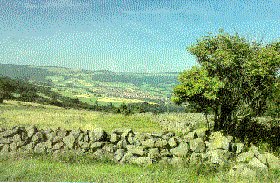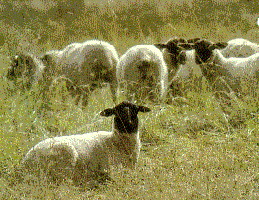 The James Hutton Institute
The James Hutton Institute
This page is no longer updated. The Macaulay Land Use Research Institute joined forces with SCRI on 1 April 2011 to create The James Hutton Institute.
 Biosphere Reserve Rhön - A model for rural regional development
Biosphere Reserve Rhön - A model for rural regional development In 1991 the Rhön, which covers parts of Bavaria, Hesse and Thuringia in central Germany, was recognised as a biosphere reserve by UNESCO to serve as a model region for low mountain areas with meadows and pastures. In case of the biosphere reserve Rhön, special attention must be given to the preservation and sustainable development of this cultivated landscape which was shaped by farmers over centuries. From the primeval forests of the region, once known as "Buchonia" (land of beeches), there
emerged a "land of open spaces" as a result of cultivation and clearing the higher regions of forests. These ecologically valuable extensive mountain meadows and pastures, which are also important for tourism, can not be kept in this open state under the general provisions of the European Union's agricultural policy. Many of these low-productive mountain meadows and pastures would, as a result of this policy, be earmarked for the heavily financially subsidised forest restocking program. As a result of this, a unique European cultivated landscape would be lost.
In 1991 the Rhön, which covers parts of Bavaria, Hesse and Thuringia in central Germany, was recognised as a biosphere reserve by UNESCO to serve as a model region for low mountain areas with meadows and pastures. In case of the biosphere reserve Rhön, special attention must be given to the preservation and sustainable development of this cultivated landscape which was shaped by farmers over centuries. From the primeval forests of the region, once known as "Buchonia" (land of beeches), there
emerged a "land of open spaces" as a result of cultivation and clearing the higher regions of forests. These ecologically valuable extensive mountain meadows and pastures, which are also important for tourism, can not be kept in this open state under the general provisions of the European Union's agricultural policy. Many of these low-productive mountain meadows and pastures would, as a result of this policy, be earmarked for the heavily financially subsidised forest restocking program. As a result of this, a unique European cultivated landscape would be lost.
The three governments in Bavaria, Hesse and Thuringia and the local communities in the six counties concerned agreed on the importance of preserving the open-space condition of the mountain meadows and pastures for reasons of nature conservation and tourism. This open-space policy was originally funded by the taxpayer. The annual costs for the most ecological valuable areas came to about 20 million German Marks. These sums are now no longer available.
A new program, "Man and Biosphere", has recently come into effect. The population of the affected areas have developed their own concepts within the framework of a unified approach to regional development. Only the technical presentation of the contributions to the discussion and findings were arranged by external advisors. By opening up new income alternatives resulting from the marketing of high-quality products from the region, a large proportion of the approximately 4000 agricultural smallholdings supplementing the main income can be assured of a continued existence. Commercial farming and forestry procedures in the Rhön, when conducted in an accord with nature, will ensure the production of high-quality goods which then are finished or processed by skilled tradesmen and then collectively marketed. This is the novel point of departure for the biosphere reserve Rhön to serve as a model. The emphasis here is not on the protection of nature by prohibitions, but on a sustainable development in accord with nature.
 Since 1991 over 300 projects adopting this new line of approach have originated in the biosphere reserve Rhön and they are well-known far beyond this region. The establishment of regional shops to provide the population with high-quality foodstuffs of local origin is one of these projects. The co-operation between farmers, skilled tradesmen for processing and innkeepers is an additional interesting starting point which has attracted much interest and imitation throughout Germany and in the neighbouring
European countries.
Since 1991 over 300 projects adopting this new line of approach have originated in the biosphere reserve Rhön and they are well-known far beyond this region. The establishment of regional shops to provide the population with high-quality foodstuffs of local origin is one of these projects. The co-operation between farmers, skilled tradesmen for processing and innkeepers is an additional interesting starting point which has attracted much interest and imitation throughout Germany and in the neighbouring
European countries.
Finally, there are a number of projects which contributed to the increasing acceptance of the biosphere reserve Rhön by the native population, which at first had sceptical of it as "a reserve imposed on them from the powers above". These projects have included the construction of new buildings in typical regional styles and built with a view to reduce the strain on resources, high-quality finishing of native timber produce in skilled craft workshops in the Rhön, a unified energy consumption plan for the Rhön and an integrated rail and bus system. Another contributing factor was the creation of about 300 qualified jobs over a period of only five years. Only with a firm conviction established in the minds of the population can the objectives of this regional development approach bring about the success which is needed for the long-term endurance of the project. The most important foundation for this future perspective was the development and the realisation of the objectives and projects by the local population.
Further information may be obtained from:
Heinrich Heß
Hess. Verwaltungsstelle
Biosphärenreservat Rhön
Georg Meilinger Str. 3
D-36115 Ehrenberg- Wüstensachsen
Tel. +49 6683-9602 -0
Fax. +49 6683- 9602-21
24th February 1997